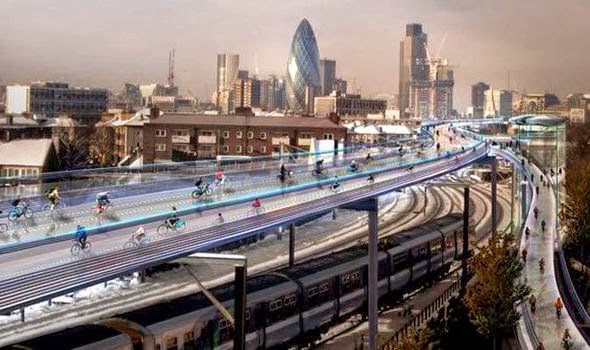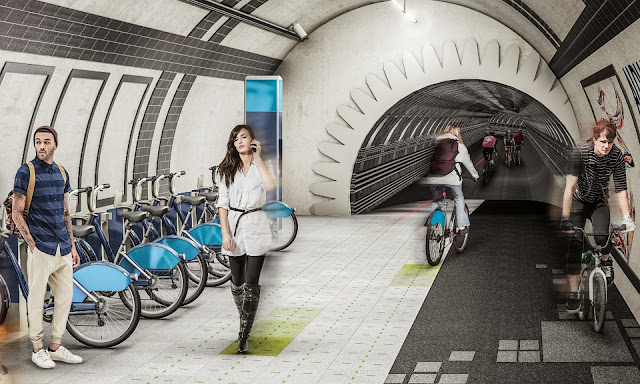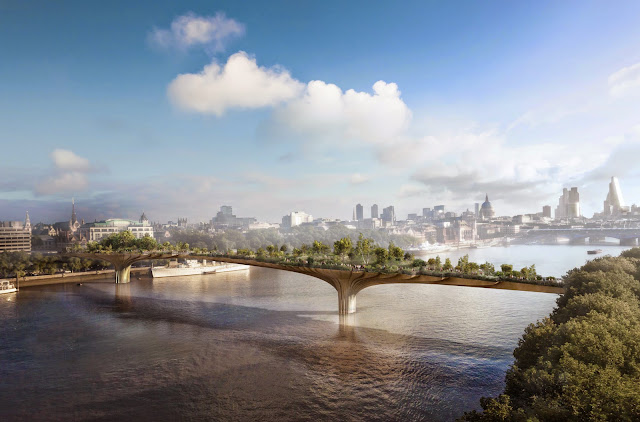
Where cities put their bicycles. Above ground. On street level. Woven into the urban fabric. Well… not ALL cities. I meet amazing, inspiring people when I travel the world with my work. I see a lot of things. Many of the things are good. Many are, however, strange and frustrating. Especially regarding infrastructure. It boggles my mind every time I - or worse, ride on - bike lanes on the wrong side of parked cars in between the door zone of primarily single-occupant vehicles and moving traffic in North American cities and I thumb my nose at every sharrow I see. That fakest of all fake bicycle infrastructure. That sheep in wolf’s clothing. Despite a century of Best Practice in bicycle infrastructure and tried and tested networks occupied by tens of thousands of daily cyclists in cities that “get it”, there are still so many mistakes being made elsewhere. I see stuff slapped lazily into place by engineers and planners who don’t ride bicycles in their city and who haven’t even tried it. Mutant Frankeninfrastructure from the lab of a Marvel Comics nemesis’ laboratory.
The streets of our cities were, for 7000 years since cities first were formed, the most democratic spaces in the history of homo sapiens. When the automobile appeared, the world's longest reigning urban dictatorship took over. Rest assured, there are signs of a Velvet Revolution (I tried to work velo into that... velovet... velo-vet... nevermind) forming. Passionate advocates for life-sized cities are meeting in earnest in the back rooms of coffee houses down the back streets. Recruiting more and more planners and even engineers - even though some of the latter group get strongarmed. Certain prominent figures are heard saying extraordinary things. Like the Mayor of Paris until last year, Bertrand Delanoë, who said, "The fact is that cars no longer have a place in the big cities of our time". He backed up his vision with action. Transforming Paris into something more beautiful in his 12 years at the helm. Not just bikes and infrastructure but traffic calming and lowering speed limits, among many other things.
Nevertheless, the motordom regime continues its rule. Erich Honecker has yet to be kissed. The transport wall remains for now.
Where there is hope, there is wackiness to make you roll your eyes, weep, utter expletives. Often all at once. There is one in every crowd, they say. The kid in the class who isn't paying attention and disrupts everyone else with unruly behaviour and lame jokes that fall flat and do little to garner respect.

£220 million for a few miles? Like Marie Kåstrup from the City of Copenhagen said, even if Copenhagen had that kind of money they wouldn't build a Skycycle. It would take cyclists off the streets and remove them from the urban fabric and places they need to go. I've written about The Ridiculous Skycycle by Norman Foster before. I let you read that. Onward.

I'll let CityLab tackle this one. They might be more diplomatic about it.

Sorry to break this to you, but there is a companion film to this "concept".
Read more about it at The Guardian. They're a bit nicer about it.
Sure, there are tunnels for cyclists. Tunnels that serve a specific function on an A to B journey. Like in San Sebastian. Like the tunnel under the river in Rotterdam, built in the 1930s. Much has been learned since then. The Dutch do an amazing job at underpasses and they keep them light and airy. The Danes pipe pleasant music into dark bike parking facilities to keep people comfortable - and generally avoid tunnels altogether, with only a few underpasses around. Keeping cyclists above ground is a design standard here.
Some people have likened the Bicycle Snake / Cykelslangen in Copenhagen to Norm's Skycycle. No. The Bicycle Snake is a BRIDGE. Solving a problem at one specific location. Not putting cyclists out of sight, out of mind. Apples and oranges. Arsenal and Tottenham.
If you look at innovation - real innovation - regarding bicycle infrastructure, you'll notice that it always prioritizes cyclists and serves a practical, logical function. The Bicycle Snake is a great example. The Floating Roundabout in Eindhoven? Same thing. The Green Wave for cyclists, rain sensors for cyclists, Or any of these things mentioned here.
You'll also notice that they are simple in nature. Simple, rational and functional. Based on an understanding of how bicycles in cities used to work, still work and can work.We have everything we need. We know everything we need to know. What to shift people over to other modern, intelligent transport forms? This is all you need.
Innovation in cities is simple. Use 7000 years of experience. It's right there. It's free. It works. Truly smart cities don't overcomplicate.
Ah, but wait. After that three act debacle is there hope? A splendid new bridge in London, spanning the Thames, providing a new mobility link in a city that desperately needs them. Oh... wait. The celebrity who is drumming up support for this, her baby, won't allow bicycles on it. The village idiot is at it again. Disrupting the class. Tokyo and Berlin are ignoring him. Copenhagen and Paris are plotting a wedgie at recess behind the bike shed. Buenos Aires, New York and Dublin are just pointing and laughing.
Samuel Johnson famously quipped that, "...when a man is tired of London, he is tired of life." That was 1777. Nowadays, regarding urban innovation, when a person is tired of London, they give it one star on TripAdvisor, a scathing review and they hop on the Eurostar to Paris or fly to Berlin or Barcelona or Copenhagen or Amsterdam or... etc.




